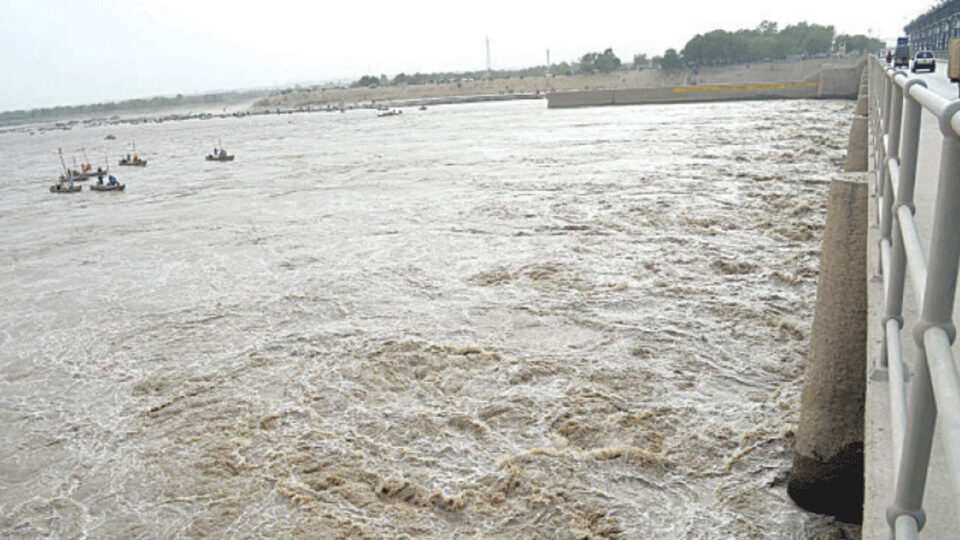Medium Flood at Guddu Barrage, Sukkur Remains at Low Flood as Modernization Efforts Continue
HYDERABAD: A medium-level flood is currently passing through Guddu Barrage, while Sukkur Barrage continues to experience low flood levels, according to data recorded on Sunday evening.
Both barrages have recently seen significant infrastructure upgrades under the World Bank-funded Sindh Barrages Improvement Programme (SBIP). Critical portions of this modernization effort were completed ahead of the 2024 flood season, with remaining work scheduled to resume in October once flood risks subside.
Current Water Discharges at Major Barrages
-
Guddu Barrage
-
Upstream discharge: 405,650 cusecs
-
Downstream discharge: 367,888 cusecs
-
Status: Medium flood (between 350,000 – 500,000 cusecs)
-
-
Sukkur Barrage
-
Inflow: 300,050 cusecs
-
Downstream discharge: 241,000 cusecs
-
Status: Low flood
-
Note: A significant volume is being diverted to seven major canals on both right and left banks
-
-
Kotri Barrage
-
Upstream discharge: 142,228 cusecs
-
Downstream discharge: 99,763 cusecs
-
Status: Normal
-
Officials expect medium flood conditions at Guddu Barrage to persist for several more days. However, it remains uncertain if Sukkur Barrage will transition to medium flood levels.
Water Storage in Major Dams
-
Tarbela Dam (Indus River):
-
Inflow: 301,700 cusecs
-
Outflow: 273,600 cusecs
-
-
Mangla Dam (Jhelum River):
-
Inflow: 31,187 cusecs
-
Outflow: 7,000 cusecs
-
Sukkur Barrage Gets Major Overhaul After Nearly a Century
In a landmark upgrade, 16 mechanized gates have been installed at Sukkur Barrage — a first since its construction in 1932. These gates now feature enhanced height (23 feet), raised by 2 feet from the original 21 feet, to improve water management and canal performance.
According to Sukkur Barrage Chief Engineer and SBIP Project Director Pritam Das, another 28 gates will be replaced by 2026. Sukkur Barrage originally had 56 gates, though 10 were permanently closed in the late 1930s due to silt accumulation, reducing its designed discharge from 1.5 million to 0.9 million cusecs.
“The newly mechanized gates eliminate the need for counterweights and will now operate using modern systems,” said Mr. Das.
Guddu Barrage Also Undergoing Upgrades
At Guddu Barrage, located upstream from Sukkur, 35 of 65 gates have already been replaced. An additional 20 gates are scheduled for 2026, with the final 10 to be completed in 2027. Similar modernization of regulators for off-taking canals is underway across both barrages.
The total cost of the Sindh Barrages Improvement Programme is estimated at Rs. 74 billion. Temporary coffer dams used during construction at Sukkur have now been removed and will be reconstructed once the flood season concludes.
Structural Issues Prompted Urgent Repairs
In June 2023, significant structural damage was discovered at gate-47 of Sukkur Barrage, where the upper portion was washed away. Subsequent inspections revealed damage to six more gates, prompting immediate emergency repairs.
An inquiry committee later identified “deferred maintenance” as the primary cause of these damages, highlighting the urgent need for continued investment in the barrage’s safety and performance.
Future Outlook
With climate change impacting flood patterns and increasing strain on Pakistan’s water infrastructure, the modernization of Guddu and Sukkur Barrages is seen as a critical step toward ensuring reliable irrigation and flood control across Sindh.
The government’s proactive efforts — including mechanization, structural enhancements, and digital monitoring — aim to make the province more resilient to future water challenges.

